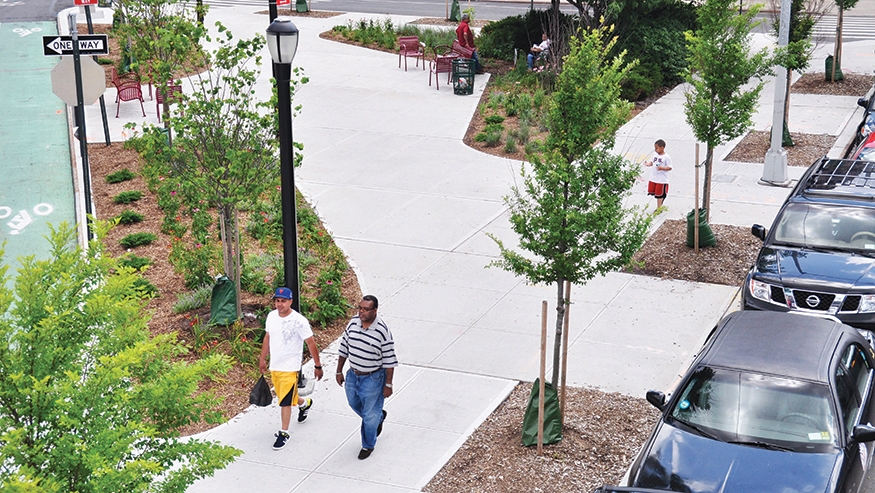This chapter provides general guidelines for the selection, design, installation, and maintenance of plantings in the public right-of-way (ROW). It reflects current practices and initiatives such as OneNYC, DOT’s NYC Plaza Program, and DEP’s Green Infrastructure Plan.
The chapter is organized by planting location, except for Tree Bed and Stormwater Management Practices as these should be pursued wherever conditions allow.

Benefits of Plantings in the Right-of-Way (ROW)
Vegetation within the public ROW has been shown to provide significant benefits. Generally, these benefits increase exponentially as the size of the planting increases; this is particularly true for trees.
All plantings:
- Capture carbon dioxide and particles from the air
- Reduce the urban heat island effect, decreasing energy costs related to air temperatures
- Allow for passive and/or active stormwater management
- Dampen street noise, providing health and psychological benefits
- Provide urban wildlife habitat opportunities; including for pollinator species if carefully selected
- Make streets appear narrower to drivers, thereby causing them to drive slower, and enhancing safety
- Create a positive aesthetic that attracts customers to local businesses
- Increase the value of adjacent properties
- Make streets and neighborhoods more attractive
- Improve pedestrian comfort by providing shade, cover from rain and/or protection from wind
- Encourage outdoor activity
Guidance Sources
More comprehensive guidance on the planning, design, installation, and maintenance of plantings within New York City is contained in sources such as High Performance Landscape Guidelines: 21st Century Parks for NYC (Design Trust for Public Space and NYC Parks, 2011), High Performance Infrastructure Guidelines (Design Trust for Public Space and DDC, 2005), Tree Planting Standards (NYC Parks, 2016), Native Species Planting Guide for New York City (NYC Parks, 2019), Standards for Green Infrastructure (DEP, 2017), the Sustainable Urban Site Design Manual (DDC Office of Sustainable Design, 2008), and Design and Construction Excellence 2.0 Guiding Principles (DDC, 2016).
Other resources include DEP’s Green Infrastructure website, NYC Parks’ MillionTreesNYC website, the NYC Parks Interactive Tree Map, the New York State Stormwater Design Manual, the Cornell University Urban Horticulture Institute website, the New York Restoration Project website, EPA’s National Menu of Best Management Practices, and FHWA’s Roadside Best Management Practices that Benefit Pollinators.
Applicability and Exceptions
All new projects that significantly impact public and private streets should follow these guidelines. DOT approval will be based on site-specific conditions and cost-effective engineering standards and judgment, with the safety of all street users being of paramount importance.
Usage Categories
This chapter does not apply usage categories to landscape treatments. Plantings are encouraged wherever site conditions allow and appropriate maintenance can be provided. Plants must always be chosen based on site specific conditions.
There are certain treatments, noted throughout the chapter, that are considered standard. These treatments will be installed and maintained by the city. Other entities may also pursue these treatments and they will generally require less intensive review. Non-standard treatments may also be pursued, but may require more extensive review depending on the complexity and scope of the project.

